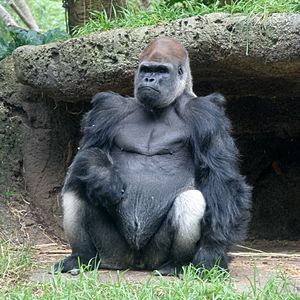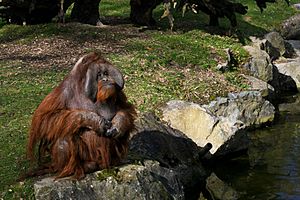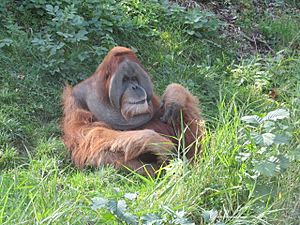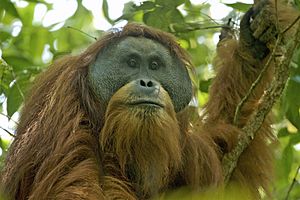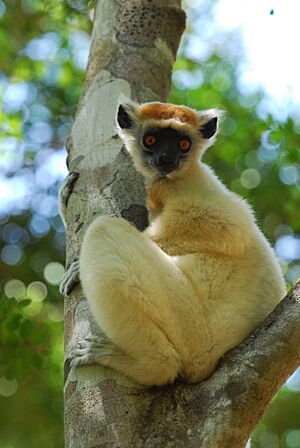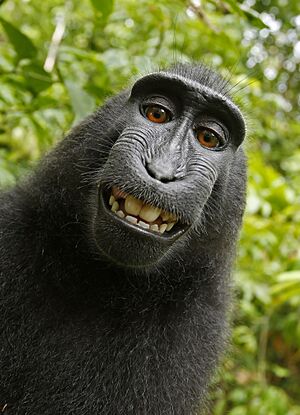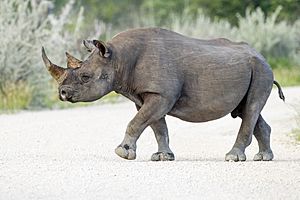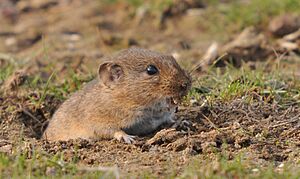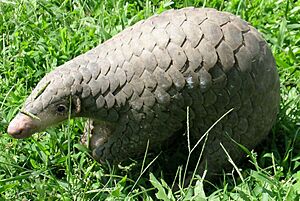List of critically endangered mammals facts for kids
Imagine a world where some of our favorite animals might disappear forever. That's what "critically endangered" means. It's the most serious warning level for animals and plants. It means they are at a very, very high risk of becoming extinct in the wild. The International Union for Conservation of Nature (IUCN) is a global group that checks on the health of species around the world. As of early 2020, they listed 203 different kinds of mammals as critically endangered. This includes 31 species that might already be extinct, meaning they haven't been seen in a long time.
About 3.5% of all mammals that the IUCN has checked are critically endangered. They also list many mammal subspecies (smaller groups within a species) and even specific populations within a species as critically endangered. Sometimes, there isn't enough information to know how many of an animal are left. These are called "data deficient." Even though we don't know their exact status, the IUCN suggests we should still pay close attention to them. This list shows some of the mammals that need our help the most.
Contents
Primates: Our Closest Relatives
There are 63 species and 36 subspecies of primates that are critically endangered. Primates include monkeys, apes, and lemurs.
Gibbons: Singing Apes
Gibbons are known for their loud calls and swinging through trees.
Species
- Black crested gibbon
- Tonkin black crested gibbon
- West Yunnan black crested gibbon
- Central Yunnan black crested gibbon
- Laotian black crested gibbon
- Hainan black crested gibbon
- Northern white-cheeked gibbon
- Eastern black crested gibbon
Great Apes: Our Big Cousins
Great apes are some of the smartest animals. They include gorillas, orangutans, and chimpanzees.
Species
Subspecies
Lemurs: Unique to Madagascar
Lemurs are primates found only on the island of Madagascar. They come in many shapes and sizes.
Species
- Sibree's dwarf lemur
- Gray-headed lemur
- Blue-eyed black lemur
- Mongoose lemur
- Lac Alaotra bamboo lemur
- Golden bamboo lemur
- Greater bamboo lemur
- Indri
- Manombo sportive lemur
- Sahamalaza sportive lemur
- Northern sportive lemur
- Hawks' sportive lemur
- Gerp's mouse lemur
- Marohita mouse lemur
- Silky sifaka
- Diademed sifaka
- Perrier's sifaka
- Golden-crowned sifaka
- Red ruffed lemur
- Black-and-white ruffed lemur
Subspecies
Tarsiers: Big-Eyed Night Hunters
Tarsiers are small primates with huge eyes, perfect for seeing at night.
Species
Subspecies
- Natuna Islands tarsier
Old World Monkeys: Diverse and Widespread
These monkeys live in Africa and Asia. They include macaques, colobus monkeys, and langurs.
Species
- Celebes crested macaque
- Pagai Island macaque
- Niger Delta red colobus
- Preuss's red colobus
- Miss Waldron's red colobus
- Sarawak surili
- Red-shanked douc
- Gray-shanked douc
- Black-shanked douc
- Tonkin snub-nosed monkey
- Myanmar snub-nosed monkey
- Pig-tailed langur
- Delacour's langur
- Cat Ba langur
- White-headed langur
- Popa langur
Subspecies
- Zammarano's monkey
- Presbytis chrysomelas chrysomelas
- Tricolored langur
- Golden-bellied Mentawai Island langur
- Western purple-faced langur
- Pagai Island pig-tailed snub-nosed monkey
- Siberut Island pig-tailed snub-nosed monkey
- Natuna Islands silvery lutung
New World Monkeys: From the Americas
These monkeys live in Central and South America. They include spider monkeys, howler monkeys, and capuchins.
Species
Subspecies
- Northern brown howler
- Mexican howler
- Azuero howler
- Brown-headed spider monkey
- Colombian spider monkey
- Azuero spider monkey
- Nicaraguan spider monkey
- Mexican spider monkey
- Ateles hybridus brunneus
- Hybrid spider monkey
- Margarita Island capuchin
Lorises: Slow and Stealthy
Lorises are small, slow-moving primates found in Asia.
Odd-Toed Ungulates: Hoofed Mammals
These animals have hooves with an odd number of toes, like horses and rhinoceroses.
Species
Subspecies
- Northern white rhinoceros (possibly extinct in the wild)
Cetartiodactyls: Whales, Dolphins, and Hoofed Animals
Cetartiodactyla is a large group that includes amazing animals like dolphins and whales, as well as hoofed animals like deer and giraffes. There are 15 species, nine subspecies, and nine specific groups of cetartiodactyls that are critically endangered.
Non-Cetacean Even-Toed Ungulates
These are hoofed animals with an even number of toes.

Species
- Addax
- Bawean deer
- Hirola
- Kouprey (possibly extinct)
- Tamaraw
- Wild Bactrian camel
- Giant muntjac
- Dama gazelle
- Saola
- Visayan warty pig
Subspecies
- Tora hartebeest
- Giant sable antelope
- Upemba lechwe
- Russian saiga
- Western giant eland
- Mountain bongo
- Kordofan giraffe
- Nubian giraffe
Cetaceans: Whales and Dolphins
These are marine mammals that live in the ocean.
Species
- Baiji (possibly extinct)
- Vaquita
- Rice's whale
- North Atlantic right whale
- Atlantic humpback dolphin
Subspecies
Subpopulations
- Bowhead whale (1 subpopulation)
- Beluga whale (1 subpopulation)
- Gray whale (1 subpopulation)
- North Pacific right whale (1 subpopulation)
- Irrawaddy dolphin (5 subpopulations)
- Harbour porpoise (1 subpopulation)
- Indo-Pacific humpbacked dolphin (1 subpopulation)
- Common bottlenose dolphin (1 subpopulation)
Marsupials: Pouch Mammals
Marsupials are mammals that often carry their young in a pouch, like kangaroos and koalas.
- Talaud bear cuscus
- Woylie
- Mountain pygmy possum
- Wondiwoi tree-kangaroo
- Golden-mantled tree-kangaroo
- Tenkile
- Black dorcopsis
- Leadbeater's possum
- Northern hairy-nosed wombat
- Handley's slender opossum
- One-striped opossum (possibly extinct)
- Northern glider
- Telefomin cuscus (possibly extinct)
- Gilbert's potoroo
- Kangaroo Island dunnart
- Black-spotted cuscus
- Blue-eyed spotted cuscus
Carnivora: Meat Eaters
Carnivores are animals that primarily eat meat. This group includes cats, dogs, and bears.
Species
Subspecies
Subpopulations
- African wild dog (2 subpopulations)
- Lion (1 subpopulation)
- Anatolian leopard
- Persian leopard (several subpopulations)
Eulipotyphla: Shrews and Moles
This group includes small, insect-eating mammals like shrews and moles.
- Phillips' Congo shrew
- Andaman shrew
- Harenna shrew
- Jenkins' shrew
- Nicobar shrew
- Christmas Island shrew (possibly extinct)
- Wimmer's shrew
- Nelson's small-eared shrew
- Eisentraut's mouse shrew
- Sclater's shrew
- San Cristobal shrew
- Russian desman
Lagomorpha: Rabbits and Pikas
This group includes rabbits, hares, and pikas.
Rodents: Gnawing Mammals
There are 58 species and one subspecies of rodent assessed as critically endangered. Rodents are known for their strong, continuously growing front teeth.
Hystricomorpha: Porcupine-like Rodents
This group includes animals like porcupines and guinea pigs.
- Bolivian chinchilla rat
- Garrido's hutia (possibly extinct)
- Santa Catarina's guinea pig
- Reig's tuco-tuco
- Roig's tuco-tuco
- Social tuco-tuco
- Mexican agouti
- Dwarf hutia (possibly extinct)
- San Felipe hutia (possibly extinct)
- Pacific degu
- Mantiqueira Atlantic tree-rat
- Short-furred Atlantic tree-rat
- Red-crested tree rat
- Golden vizcacha rat
- Chalchalero viscacha rat
Myomorpha: Mice, Rats, and More
There are 37 species in Myomorpha assessed as critically endangered. This group includes many types of mice, rats, and hamsters.
Murids: True Mice and Rats
This family includes common mice, rats, and gerbils.
- Elvira rat
- Dahl's jird
- Ethiopian amphibious rat
- Poncelet's giant rat
- Muennink's spiny rat
- Biak giant rat
- Emma's giant rat
- Emperor rat
- Guadalcanal rat
- Carpentarian rock rat
- Central rock rat
Cricetids: Hamsters, Voles, and New World Rodents
This group includes hamsters, voles, lemmings, and many New World rats and mice.
- European hamster
- Chinanteco deer mouse
- Delicate deer mouse
- Ixtlán deer mouse
- Zempoaltepec deer mouse
- Habromys schmidlyi
- Zuniga's dark rice rat
- Bavarian pine vole
- Nelson's woodrat
- Perote mouse
- Burt's deer mouse
- Dickey's deer mouse
- Angel Island mouse
- San Lorenzo mouse
- Maya mouse
- Puebla deer mouse
- False canyon mouse
- Catalina deer mouse
- San Esteban Island mouse
- Cozumel harvest mouse
- Chiapan climbing rat
- Tumbala climbing rat
Nesomyids: African and Madagascan Rodents
- Mount Kahuzi climbing mouse
Castorimorpha: Beaver-like Rodents
This group includes beavers and pocket gophers.
Species
- San Quintin kangaroo rat
- Tropical pocket gopher
- Big pocket gopher
Subspecies
- Alcorn's pocket gopher
Sciuromorpha: Squirrel-like Rodents
This group includes squirrels, marmots, and chipmunks.
Bats: Flying Mammals
Bats are the only mammals that can truly fly. They are found all over the world.
- Bulmer's fruit bat (Aproteles bulmerae)
- Seychelles sheath-tailed bat (Coleura seychellensis)
- Philippine naked-backed fruit bat (Dobsonia chapmani)
- Thongaree's disc-nosed bat (Eudiscoderma thongareeae)
- Kolar leaf-nosed bat (Hipposideros hypophyllus)
- Lamotte's roundleaf bat (Hipposideros lamottei)
- Fijian monkey-faced bat (Mirimiri acrodonta)
- Bala tube-nosed bat (Murina balaensis)
- Gloomy tube-nosed bat (Murina tenebrosa) (possibly extinct)
- Armenian whiskered bat (Myotis hajastanicus)
- Yanbaru whiskered bat (Myotis yanbarensis)
- New Zealand greater short-tailed bat (Mystacina robusta) (possibly extinct)
- Jamaican greater funnel-eared bat (Natalus jamaicensis)
- New Caledonian long-eared bat (Nyctophilus nebulosus)
- New Guinea big-eared bat (Pharotis imogene) (possibly extinct)
- Jamaican flower bat (Phyllonycteris aphylla)
- Canary long-eared bat (Plecotus teneriffae)
- Sardinian long-eared bat (Plecotus sardus)
- Greater monkey-faced bat (Pteralopex flanneryi)
- Montane monkey-faced bat (Pteralopex pulchra) (possibly extinct)
- Aru flying fox (Pteropus aruensis) (possibly extinct)
- Livingstone's fruit bat (Pteropus livingstonii)
- Vanikoro flying fox (Pteropus tuberculatus)
- Hill's horseshoe bat (Rhinolophus hilli)
Other Mammals
This section includes other unique mammals that are critically endangered.
Species
Subspecies
Subpopulations
- Juliana's golden mole (1 subpopulation)
See also
- Lists of IUCN Red List critically endangered species
- List of least concern mammals
- List of near threatened mammals
- List of vulnerable mammals
- List of endangered mammals
- List of recently extinct mammals
- List of data deficient mammals



